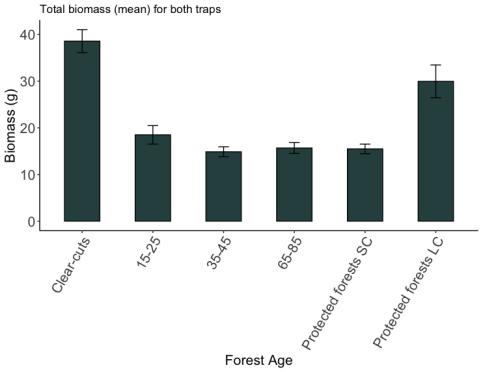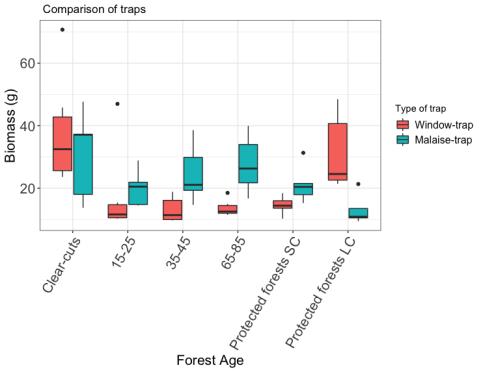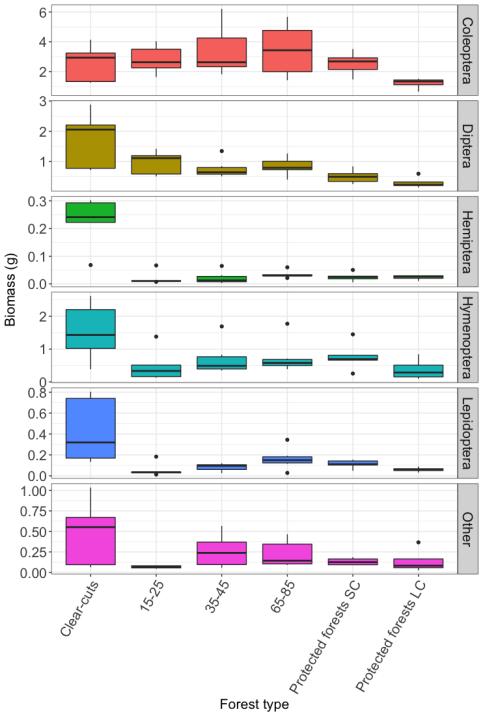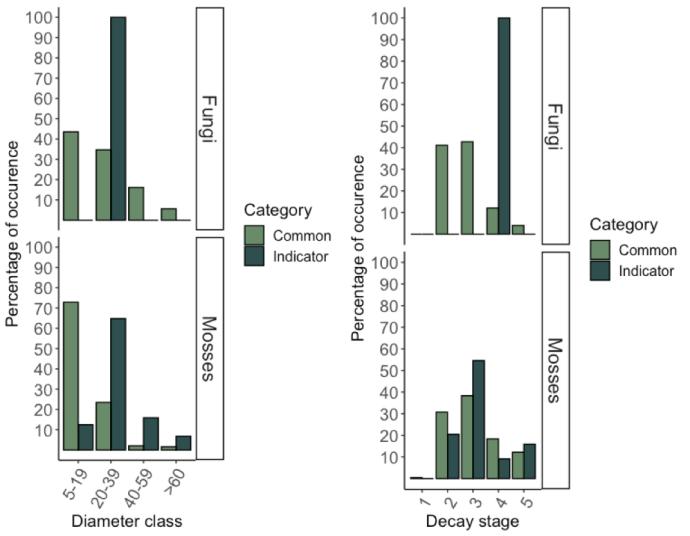Findings & Conclusion
Total biomass of flying insects

The biomasses from all window trap catches, and all malaise trap catches were summed and generated a total weight of 8.43 kg. Differences in total biomass between forest age was tested with a one-way Anova. Analyses showed a significant difference between forest ages (F (5, 375) = 25.13, p = < 0.001), where clear-cuts and old-growth forest both had a significant higher biomass compared to the other forest ages. The highest biomass is to be found in Clear-cuts, followed by the protected forests with a long continuity. Together clear-cuts and old growth forest generated almost 50 % of all biomass, of which clear-cuts had 30 % and old-growth forests 19 %. The other, younger, protected forests are pretty equal to the different ages of production forests in insect biomass.

Comparison of insect biomass between the two traps
Insect biomass differed between the two trapping methods and forest types. Malaise traps had higher biomass for all production forests and production forests with shorter continuity, whereas the Window-traps had much higher weight in the protected forests with a longer continuity.
Biomass for five insect orders

Clear-cuts generated the highest amount of biomass for all orders, except for beetles (Coleoptera), which tends to have a higher weight in different ages of production forests (Figure 2). For all areas, beetles were the order that generated the highest weight with a total weight of 91.17 g (56%), followed by Diptera with 29.67 g (18.2%), Hymenoptera with 27.16 g (16.7%), other with 7.53 (4.6), and Lepidoptera with 5.45 (3.3 %). Hemiptera was the order that generated the least amount of biomass with only 1.98 g (1.2 %).
Dead wood quantity and quality
Overall, protected forests with a long continuity had a significantly higher volume (m3 ha -1) of dead wood than all other forest types. Although, protected forests still had significantly more than any of the production forests. The size distribution showed a dominance of smaller logs and snags with a diameter between 5-19 cm for all forest ages (Figure x A). However, protected forests had more variation in diameter classes, and more variation in, and a higher volume of different decay stages. Dead trees with a diameter >60 cm was found almost exclusively in old-growth forests.
Wood-inhabiting mosses and fungi
During the field study, 15 out of 22 species of wood-inhabiting mosses and fungi were found on the inventoried logs and snags. Of those 15 species, five are considered species that indicates high natural values of which four of them exclusively were found in the protected forests. A generelized linear model showed that the probabilty for a indicator species to excist increased with an increasing volume of dead wood and tree species of dead wood.
Regarding diameter classes, most indicator species only seem to establish themselves when the diameter exceeds 20 cm, while more common species are commonly found on logs with a smaller diameter (Figure 3). It is more difficult to say anything about the fungi species since the only indicator species found only occurred once. A decay stage of at least three seems to be important for many indicator species, whereas more common species seem to be established regardless of the decay stage (Figure 3).

Conclusion
Clear-cuts and protected forests with a long continuity had the highest amount of biomass. The two traps are designed to catch insects from different insect orders and the results showed that biomass varied with regards to trapping method. This means that to best estimate the insect production, several trapping methods needs to be used.
For dead wood quantity and quality, an increasing volume of dead wood, and more tree species of dead wood increased the probability for both common and indicator species to exists. Common species were mainly found on smaller logs whereas indicator species of high natural values established mainly on logs with a diameter of at least 20 cm. Thus, a variation in diameter and decay stage is of great importance. The findings of this study support the importance of forest continuity to maintain a high biodiversity.
Responsible for this page:
Director of undergraduate studies Biology
Last updated:
05/31/21
